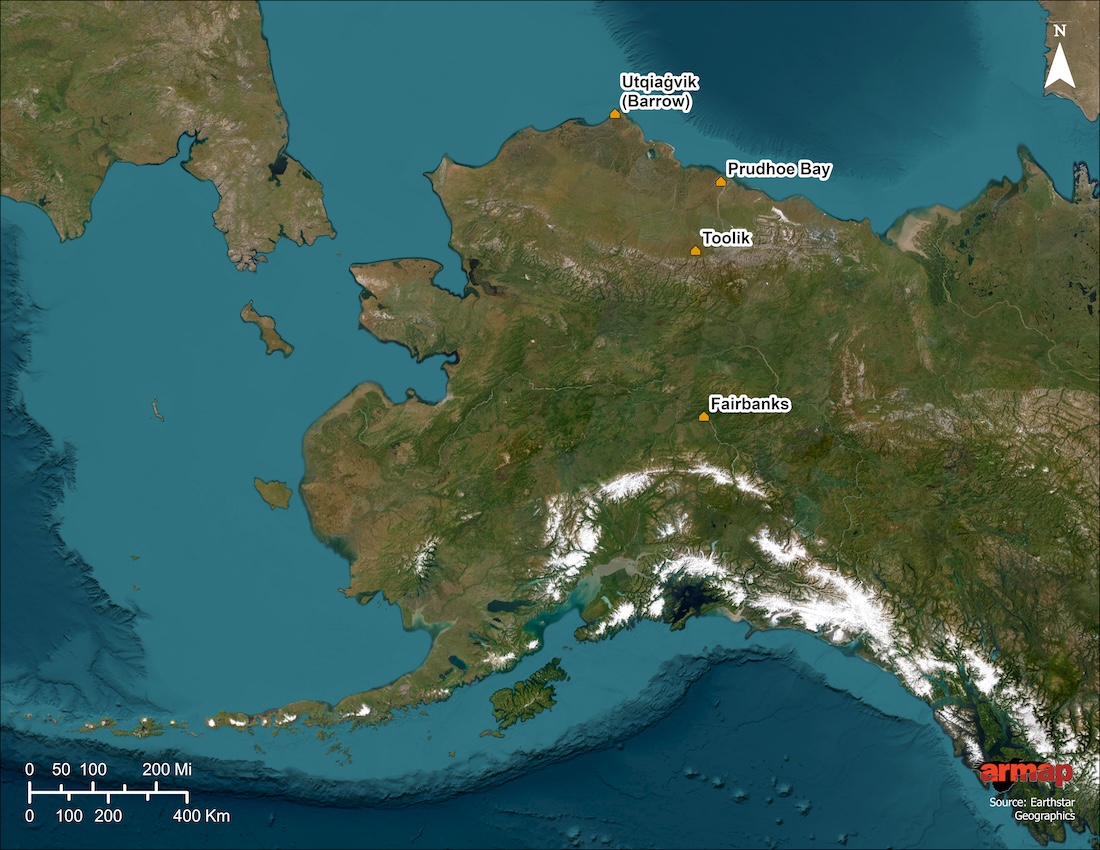
ALASKA
Photo by: Mark Urban
Alaska’s 663,268 square miles of land area is larger than Texas, California, and Montana combined. The state’s size, numerous landscapes, extreme climatic conditions, scattered population, and limited infrastructure all pose challenges to supporting research in Alaska. Compounding these are the complex politics of land ownership, sensitivities to operating in areas where people live, and use of resources by Indigenous communities for subsistence.
The Battelle ARO team provides support to researchers by hiring experienced local and Indigenous support staff, using established and proven logistics support hubs in Fairbanks and Utqiaġvik, providing tailored support for remote project locations, and providing guidance on engagement and outreach programs for involving local and Indigenous communities.

Photo by: Faustine Bernadac
BATTELLE ARO HUBS IN ALASKA
FAIRBANKS
Support operations for much of the state begins at the Battelle ARO office in Fairbanks.
Fairbanks Details
The Fairbanks office houses science project managers for local planning and coordination, plus a warehouse and shop for access to clean, heated areas to stage, train, and store overwinter gear.
The Battelle ARO team can provide the below level of support for NSF-funded researchers:
- Orientations and training
- Coordination of local travel
- In-state travel arrangements for special fixed-wing or helicopter charters, and lodging
- Community liaison activitie
- Coordination of science cargo and sample storage and movements
- Fabrication and repairs
Contact Arctic.Outreach.Alaska@Battelle.org for more information.
Battelle ARO Fairbanks Office
2325 King Road
Fairbanks AK 99709
907.455.4214
PRUDHOE BAY
Supporting researchers working in the Prudhoe Bay vicinity, in the community of Deadhorse.
Prudhoe Bay Details
Battelle ARO helps researchers working in the Prudhoe Bay vicinity, in the community of Deadhorse, navigate the unique requirements of working in an area solely focused on the oil industry. Due to significant oilfield activity, any work in this area must be arranged and scheduled months in advance.
Researchers intending to work on the oilfields must contact the appropriate oilfield representatives for authorization and badging. Battelle ARO can assist with the costs of training, including the North Slope Training Co-operative Unescorted class (9–10-hour class).
TOOLIK FIELD STATION
This research station is funded by the National Science Foundation and operated by The Institute of Arctic Biology (IAB), a division of the University of Alaska at Fairbanks.
Toolik Field Station Details
Toolik Field Station (Toolik) is operated and managed by the Institute of Arctic Biology at the University of Alaska, Fairbanks, with support from the NSF. On-site labs are available year-round, as are science and communication equipment and vehicles for accessing the coastal plains and foothills of the Brooks Range. In summer, helicopters get scientists, and gear to remote sites.
Projects may be subject to multiple permitting requirements. Researchers should plan for 12 months of lead time for any activities, including construction support, remote power systems, support buildings, etc.
Researchers should budget for Bureau of Land Management (BLM) land use permit fees in their proposal budgets, and submit a permit application. Fees for the BLM average $1,000 per year. If a project may disturb the tundra from construction, or fieldwork, the permit could be up to $5,000.
For additional information on permitting, see Permits and Policies | Toolik Field Station (uaf.edu)
UTQIAGVIK
Utqiaġvik (formerly Barrow) is a small North Slope community accessed via daily flights from Anchorage and Fairbanks.
Utqiaġvik Details
NSF funded field support for the North Slope, the Chukchi and Beaufort Seas, and sea ice often begins in Utqiaġvik. This year-round Battelle ARO hub provides access to the Barrow Arctic Research Center (BARC), a state-of-the-art laboratory space, and the Charles Itok Edwardsen Barrow Environmental Observatory.
Planning for Battelle ARO supported field work by NSF-funded projects in Utqiaġvik is done by Battelle ARO partner, Ukpeaġvik Iñupiat Corporation (UIC) Science. UIC Science staff provide project permitting and on-the-ground logistics support. Researchers new to Utqiaġvik are encouraged to visit UIC Science Support.
- All projects are subject to permitting. Battelle ARO assists with applications and fees for UICS staff who will plan and prepare applications for North Slope Borough (NSB) and UIC Land Use permits.
- Battelle ARO also conducts environmental impact consultations with the US Fish and Wildlife Service (USFWS).
- Additional permitting may be required for researchers accessing sites on BLM-administered lands or waters in the National Petroleum Reserve Alaska, including Elson Lagoon. Please contact Donna Wixon for further information. Researchers should include costs for all BLM permitting direct-to-grant, currently $1000 per year.
REMOTE ALASKA
Supporting remote field camps, traverses, and fieldwork in small villages throughout Alaska.
Remote Alaska Details
Battelle ARO excels in planning support for scientists visiting sites with little or no infrastructure in place. Examples include the Yukon River, Atigun Pass in the Brooks Range, Gates of the Arctic National Park and Preserve, the Arctic National Wildlife Refuge, and the Seward Peninsula.
Additionally, Battelle ARO supports several semi-permanent field sites in Alaska each with unique requirements around land ownership, power, access and medical services:
- Imnavait Creek – on the north side of the Brooks Range, in the Kuparuk River basin, at Milepost 290 on the Dalton Highway
- Ivotuk – north of the Brooks Range
- Atqasuk – inland community of 250 people, southwest of Utqiaġvik

Photo from ARMAP
Environmental Compliance
Securing permits for fieldwork can be challenging with long lead times. Although researchers are responsible for all permitting related to their fieldwork, the Battelle ARO team is available to assist and provide guidance throughout the permitting process. Battelle ARO can help identify required permits and provide expertise in specific areas that require local knowledge or other key agency contacts. Review the guide for more detailed information.
